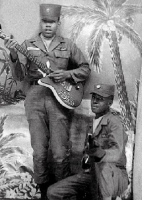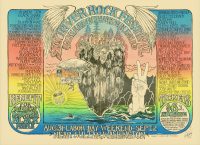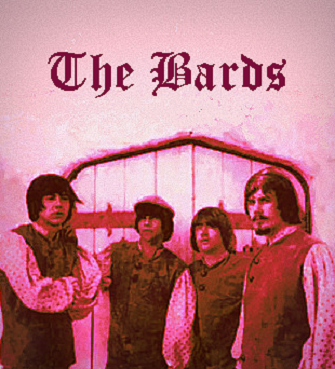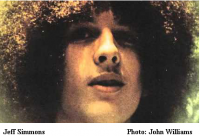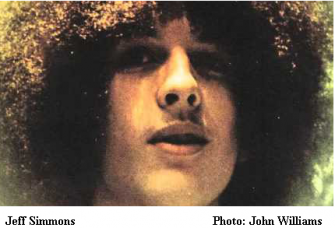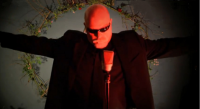
It’s September 15, 2019. I’m on the phone with Tom Dyer from his home in Olympia Washington. Tom tells me he was born in Des Moines Iowa, although his family moved to Olympia when he was five years old. Tom relocated back to Olympia in 2016 after decades of living elsewhere…mostly Seattle. It seems fitting that he would have moved back to Olympia…he’s spent so many of his years dedicated to music that Olympia must be a very comfortable place for him. It’s certainly a completely different town than the one he grew up in. The low-key but world-renowned Oly scene has been the birthplace of some of the nation’s best indie labels, among them K, and Kill Rock Stars. Nowadays Tom Dyer’s label, Green Monkey Records, stands alongside them.
Olympia has had an over-sized influence on pop music from the late 1950s trio The Fleetwoods, through the riot grrrl movement that unleashed Bikini Kill, Bratmobile and Sleater-Kinney to today’s Hounds or David Petty. For decades The Evergreen State College (TESC) has churned out rafts of musicians, artists, authors, and educators that have shaped pop and alternative culture. A smattering of those include illustrator Charles Burns, musician/producer Steve Fisk, John Foster author and founder of OP magazine, author/professor Mark H. Smith, illustrator and author Lynda Barry, DJ and radio host Steve Rabow, K Records founder Calvin Johnson, Benjamin Hammond Haggerty (a.k.a. Macklemore), actor Michael Richards(Cosmo Kramer of Seinfeld), Simpsons and Futurama creator Matt Groening, professor, author, activist, and journalist Robert McChesney, comedian and advocate for the differently-abled Josh Blue, Soundgarden guitarist Kim Thayil, former ‘This Old House’ host Steve Thomas, and SubPop founder Bruce Pavitt. The list goes on and on.

Tom Dyer in his studio. 2009
The college is also home to KAOS radio-one of the perennially finest college radio stations in the country. KAOS hosts Tom Dyer’s weekly Freeform NW show (1-3 PM every Wednesday, streaming at www.kaosradio.org/listen). His dedication to the pop/garage format that has long been a staple of northwest music makes him a great candidate for the show’s host.
“I get to choose ‘northwest’ as I define it. If someone says ‘Hey! You can’t include those guys from Montana!” I’m not bothered”. Tom explains that he plays music of all genres and doesn’t follow themes “There’s really no theme to that show at all, Tom says. “It’s just a grab-bag of shit” His tone is obviously more in jest than sincere.
“The fun thing with KAOS is that I get total control of what I play, Tom tells me. Although Tom has just told me ‘there’s really no theme, he says “Three weeks ago I did an Amy Denio show. It was two hours of the 8000 bands that Amy has been in.” He also tells me that two weeks prior to our conversation he did a show built around the seminal ‘Life Elsewhere‘ EP released in 1980 by Olympia’s Mr. Brown Records. The record jump-started the careers of Steve Fisk, John Foster and the band ‘The Beakers’. “So I played a bunch of stuff off ‘Life Elsewhere’, a bunch of K Records and Engram stuff…basically from 1979 to 1984.
I also play ‘John Coltrane-Live In Seattle‘ It’s a great record!.” Tom says with enthusiasm.
Although almost universally known as ‘John Coltrane: Live in Seattle’ the record’s official name is ‘John Coltrane Featuring Pharaoh Sanders Live in Seattle’. Perhaps the ‘Featuring Pharaoh Sanders’ part is dropped because the entire band recorded that night were not as well known at the time, but have since become far more famous and well respected. Just a guess. The live recording was thought to be lost, but in 1971, six years after it was recorded Impulse! Records found the tapes and released them as a double album.
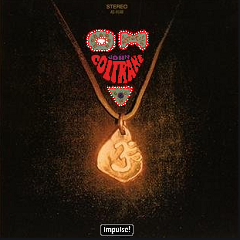
‘OM’. Recorded October 1, 1965 at Camelot Studios in Lynnwood WA . Cover Design: Robert & Barbara Flynn
For those that don’t know, Coltrane’s ‘Live in Seattle’ was one of the earliest live experiments showing the public his transition from Bebop to his more atonal and avant-garde period. Pharaoh Sanders had been a practitioner of this sound, and it was Sanders who especially brought his more experimental nature into Coltrane’s band. The performance was recorded on September 30, 1965, at Seattle’s long-gone jazz club The Penthouse. The band consisted of Coltrane and a stellar line-up that featured Pharoah Sanders on sax, McCoy Tyner on piano, Jimmy Garrison on double bass and Elvis Jones on drums.
The next day, October 1, 1965, the band set out from Seattle to Jan Kurtis (Skugstad)’s Camelot Sound Studios in Lynnwood; a town a few miles north of Seattle. It was there they recorded the album ‘Om’ As the title suggests Coltrane was familiar with the Hindu Vedas and the Bhagavad Gita by then. The title ‘Om‘ refers to the sacred syllable in Hinduism that denotes the Infinite or the entire Universe. Although Coltrane never called himself a Hindu (or any other faith) he was deeply interested in Vedic music and religion, and philosophy beginning in the mid-’50s. It coincided with his recovery from heroin in 1957 which he attributed to a general spiritual awakening. In 1964 he had the chance to study with Ravi Shankar, the maestro of the sitar, and of raga. He had also become familiar with the works of th yogi and philosopher Krishnamurti. It’s thought Coltrane was on LSD for this recording session, but it’s never been confirmed.
The band was the same as the previous nights’ appearance at The Penthouse along with noted Seattle multi-instrumentalist jazz musician Joe Brazil on flute. It’s said that Brazil had jammed with Coltrane and company live the night before. The session at Camelot was produced by the near-legendary Bob Theile. Although recorded in 1965, the recordings were released on Impulse! Records January 1968, about six months after Coltrane died of July 17, 1967, of liver cancer. At the time of its release critics and fans savaged it, even calling it Coltrane’s “worst album”. Eventually, most of those critics and fans would come to think much better of the album, and in some cases were heavily influenced by it. By the release of ‘The Major Works of John Coltrane’ in 1992 the 29:07 track ‘Om’ was included alongside ‘Selflessness’, ‘Kulu Sé Mama’ and ‘Ascension Edition I, and ‘ Ascension Edition II’
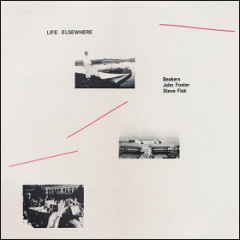
Life Elsewhere. Steve Fisk. The Beakers. John Foster. 1980
Back to Tom: “My show on KAOS is pretty borderless although it needs whatever northwest connection I put on it. That shit doesn’t sound near as crazy as it did 40 years ago. When I got ‘Life Elsewhere‘ in 1980 I thought ‘this is just fucking cool!’…and it was pretty cool…I loved ‘The Beakers‘!”
“When I was in high school there was Captain Beefheart…that was crazy as shit, but it’s not so crazy anymore; now there’s a bunch of that sort of thing. I get to play Zoot Horn Rollo,” (a.k.a. Bill Harkleroad, formerly of Captain Beefheart’s Magic Band). “He was my guitar teacher (via Skype). He lives in Eugene Oregon. Occasionally I play something from his solo album ‘We Saw A Bozo Under The Sea’. I get to make up the rules.!
Tom has some other experience in radio. In the ’80s he was host of the show Audioasis on the U of W’s alternative station, KCMU. “That’s where I first met Jonathan Poneman”. (before SubPop). Jon referred to me as a ‘Record Mogul’ back then. I guess we know how that turned out!” Tom says, with a chuckle. “I don’t begrudge them their success. They occasionally put stuff I like besides Mudhoney, who I usually like anyway. I think they did a lot of clever label stuff when they started, and for better or worse, they got lucky. They got ‘hold of the magic ring. Who doesn’t want that? I think it is great they’ve kept it going so long”.
Tom tells me that during his years at Olympia High School he was the singer in several cover bands. “I didn’t know many of the words, so I just made them up,” he admits. “One of the band’s name was Sahara Pack Frame. We played almost the entire ‘The Family that Plays Together’ album by Spirit. We also played my so-called composition Black Death.”
“After I graduated in 1970 I couldn’t get the fuck out of Olympia fast enough. It was like ‘LET ME OUT!!! Tom bummed around the northwest between Alaska and Oregon for a few years before landing in Seattle in 1975. ’. “In my 20’s I took up guitar and sax,” Tom says. “My first Seattle band was The Adults.”
In 1979 Tom met Harvey and Deanne Tawney who, along with Tom, shared an appreciation of Ornette Coleman, Captain Beefheart, free jazz…and The Dave Clark Five. In the beginning, they experimented with improvisation, going by the name The Pigments. In early 1980 The Pigments changed its name to The Adults and mostly gave up improvisation in favor of straight-ahead rock. During their stint as The Adults, Tom, Harvey, and Deanne were joined by bass players first the author Adam Woof and later Howie Wahlen. Somewhere along the way Bob Blackburn would become their single bassist as well as doing some vocals and writing some of the band’s songs.
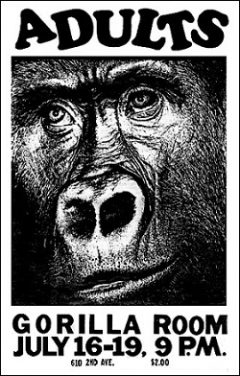
Poster by Tom Dyer & The Adults
t wasn’t long until another new name and a new format came about; The Adults became The Colorplates. By returning to some experimentation the band was afraid of being pigeonholed into the cringe-worthy, catch-all lump of bands meaninglessly designated as ‘art-rock’. The Colorplates ran like hell from that cursed label, and one of the best ways to do it was to dive deeply into another ill-defined genre called either punk-rock; or worse…post-punk. Later, in a partially tongue-in-cheek bio for The Colorplates Tom wrote:
“They mainly played punk joints like the Gorilla Room and the UCT Hall with bands like Student Nurse, The Pudz and Pell Mell. Mostly for friends, but occasionally for sailors. They managed to do a bit of recording…none of it made it to vinyl, which was the punk rock mark of success back then.”
Tom’s next move was to form The Icons, a band which lasted roughly between 1981 and 1985. The band included Tom on guitar vocals and keyboards, Steve Trettevick on keyboards and vocals, Rick Yust on bass and back-up vocals, and Tim Nelson on drums…as well as back-up vocals on one song. The Icons recorded one album, ‘Masters of Disaster’ and a live album recorded at The Hall of Fame, a nightclub in Seattle’s University District. The album is known simply as ‘The Icons at the Hall of Fame’ and according to some accounts, captured their final performance. Recording at The Hall of Fame took place either on April 17 and 18 (according to the cassette’s cover) or January 3 and 4, 1986 (according to the cassette’s flip side j-card notes).
The Icons. Appointment with Destiny. 2010. Cover Art by Martin Cannon
The Icons wouldn’t play again until 2010 when Green Monkey Records released a new album called ‘Appointment with Destiny‘. It was a collection of about half of The Icons earlier songs they’d never recorded and half all-new materiel. The Icons played one show for the album at the time. After playing a show for the unveiling of ‘It Crawled From The Basement’ “The fellows had so much fun,” Tom tells me, “that they wanted to play more” Tom tells me he wasn’t interested in gigging, but he was on board with making a second album.
At the time of its release, Tom wrote ” ‘Appointment with Destiny’ is the Sgt. Pepper’s of the 21st Century. They are the walrus.”
“The Icons were Tom Dyer’s Seattle rock band in the ’80s,” a thinly disguised entry posted by ‘anonymous’ on discogs.com says: “They liked to rock, but were not very popular…” The ‘anonymous’ in this case seems to have been Tom himself. The giveaway is that Tom Dyer’s press releases, bios and just about anything else he writes is self-deprecating, includes a dry sense of humor and off-kilter observations.
Tom tells me that one night when The Icons were booked to rehearse their drummer failed to show up. The remaining members chose to get drunk and make things up. Tom says it was “Fooking Brilliant.” This configuration would become Me-Three, a band that never gigged, but released an album in 1983 called ‘No Money…No Fun’. By this time Tom was clearly was well-established in the early alternative Seattle music community. In 1982 Tom was ready to record his own solo album.
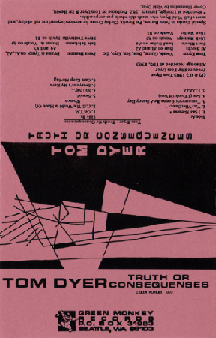
Truth or Consequences. 1982. Cover Art Vicki Dyer.
The resulting was ‘Truth or Consequences’. It included an impressive list of local guest musicians, including the late Eric Erickson (The Fishsticks, The Squirrels), Kurt Bloch (The Fastbacks), Kurt’s brother Al Bloch (The Cheaters), Pat Hewitt (of the ’60s band The Disciples, and later of the Range Hoods), Peter Barnes (The Enemy and one of Seattle’s most in-demand producer/engineers), and Steve Trettevik former keyboard player for The Icons. Dian Wells and Dick Manley did some of the backing vocals. Tom’s wife Vicki did the artwork, which would set a precedent for her doing covers for subsequent albums. After completing the album in 1983 Tom intended to sell it through the new label he’d formed, the aforementioned Green Monkey Records.
In the late ’70s and the ’80s starting an independent label was a common pursuit among bands and their friends. Very few of those labels lasted longer than two or three singles. Tops. Tom’s Green Monkey Records managed to keep afloat during its initial run from 1982 until 1991. The label’s output in 1990 included The Hitmen, Swelter Caccklebush, Mad Man Nomad and another highwater mark for The Green Pajamas, Ghosts of Love. 1991 saw the releases by The Life, Charlie & The Tunas, Joe Leonard, and anther by Mad Mad Nomad. The Green Monkeys’ cover of Leonard Cohen’s ‘Story of Issac’ was included on the compilation The 4th Adventure released by the Danish label Guiding Light Records. Green Monkey put out its own fantastic compilation in 1991 called ‘The Young and The Restless’. It included Black Happy, The Mono Men, Slam Suzanne, Bam Bam, Dr. Unknown, Blind Horse, Red Skeleton as well as 13 other artists. Oddly enough, the album’s last two tracks ‘Non-stop Pokin’ Action’ by Slobberpocket and ‘Heavin’ Tiny Sandwiches Over The Side’ by B.L.O.G. are two separate recordings by two separate bands that segue into each other and are listed as “18a” and “18b” respectively.
Running an independent label must be, above all, a labor of love. Returns on investment are rare and Tom resolved himself to that decades earlier. I ask Tom why he started his own label and got a patently obvious answer. One that was familiar to any person who’s started a small independent label-including me.
“It was to put out my music and my friends’ music. No one else was doing it. The first two cassette releases were my own album, ‘Truth or Consequences’ in 1982 and ‘Local Product’ in 1983…and so the die was cast.”
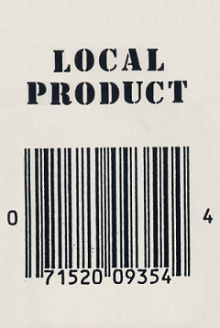
Local Product (Compilation) 1982. Cover Art by Tom Dyer.
‘Local Product’ was a compilation of bands as diverse as Mr. Epp and The Calculations, The Fastbacks, Al Bloch, The Queen Annes, Eric Erickson, along with 10 other artists. “I recorded most of it on my 4 Track,” Tom tells me. “The cover was the UPC from a twelve pack of the old (generic) Beer Beer.” Tom says he took a half-rack to Kinko’s Copiers (Now Fed Ex Office) and made a copy…” so,” he says, “that was the cover.”
The bands on ‘Local Product’ were largely unknown-and some were created as impromptu get-togethers by musicians and friends. Dawn Anderson of the local music magazine Backfire ignored the compilation when it was first released. Later she listened and practically gushed over it.
“I considered myself warned when I noticed the same names over and over for various bands (Dyer himself appears with eight of the fifteen acts featured). Inbreeding tends to lead to tunnel vision, as well as the worst form of “us against them” snobbery-always, of course, at the expense of the music. Well, apparently not always. To my surprise and delight, I found this tape was not made up of the pretentious spazz-art I was expecting–most of this is honest-to-God pop music! Garage pop, perhaps, but definitely pop, the kind with guts as well as hooks.”
I ask Tom another question I’d wanted to know the answer to for years.
“Why the name Green Monkey Records?
I’d done some homework, so I knew the Green Monkey (Chlorocebus sabaeus) is a social, vocal and generally territorial inhabitant of West Africa. Some also made their way to the islands of the Caribean during the time of the slave trade. The Green Monkey’s fur does have a greenish-yellow appearance. The most dangerous (and impolite) acts they commit are males seeking dominance by fighting and showing their blue scrotums and bright red penises in order to attract females. Researchers have studied the Green Monkey extensively because the majority of the African population carry the Simian Immunodeficiency Virus (SIV), similar to the Human Immunodeficiency Virus (HIV)… but the SIV in the Green Monkey is not as virulent as the human form, and Green Monkeys who carry SIV do not progress to having Simian Auto Immunodeficiency Syndrome. (SAIDS) , the equivalent of AIDS in humans.
Research suggests African Green Monkeys’ SIV may have lost its virulence millions of years ago and Green Monkeys almost never get sick from SIV. If SIV/SAIDS was once a monkey killer, the change in its virulence may shed light on the future course and timing of the evolution of HIV. Although it was once thought the Green Monkey had infected humans with SIV which became HIV/AIDS, it’s clear many more Green Monkeys have been infected with HIV/AIDS through research by humans than the Green Monkey passing off the virus to humans. To paraphrase Peter Gabriel ‘Shock The Monkey, Indeed!’
 Thankfully, Tom naming his label Green Monkey Records has nothing to do with showing off genitals or animal research. In fact, it’s difficult to look at the Green Monkey logo without seeing a happy green fellow with arms raised in the air as if it’s lumbering toward the viewer to give them a big hug…sans the naughty bits.
Thankfully, Tom naming his label Green Monkey Records has nothing to do with showing off genitals or animal research. In fact, it’s difficult to look at the Green Monkey logo without seeing a happy green fellow with arms raised in the air as if it’s lumbering toward the viewer to give them a big hug…sans the naughty bits.
Tom tells me that when he was a kid, his grandmother had an actual “stuffed but wise” Green Monkey in her attic. He says he acquired it around the time he launched his label. “I had to call the label something,” he says, “so there it was. It wasn’t particularly thought out.” He also notes that it is the very same “stuffed but wise” monkey that is pictured on the cover of the Green Monkey’s 2009 compilation ‘It Crawled From The Basement’.
“George Romansic thought it scary!” he adds.
“I used to lose money on the label every year, but the amount I lost was tolerable,” according to Tom. “Over a year I’d lose about a thousand or two thousand dollars,” He says that loss was low enough that he was willing to fund the label. “I set very low expectations for people from the gitgo. I’ll do some stuff and presume this is just not going to be any big seller. If I’m wrong, I’ll be happy.”
Those low expectations were one of the things Tom says he started anticipating from the beginning of Green Monkey. “ I really didn’t want to have to deal with people that thought I was an asshole when I was trying to help them,” Tom tells me. I’ve always set the expectations really appropriately. At the end of the day they may still think I’m an asshole, because I am, probably…or I could have done more, but I make it clear from the beginning what I’m going to do.”
“Most bands want indie labels to do extra things for them,” Tom bemoans. “They want you to be their manager, their booking agent or errand-runner,” Tom says “That’s all the shit I don’t want to do. It’s way too much. I managed The Green Pajamas way back when, but I haven’t done it in a long time. Jeff has wanted me to manage The Green Pajamas again. I have no problem telling him “No, I don’t’ want to do that.’ I say ‘I’ll put your records out…I’m happy to put your records out.’ Management is just doing all the shit that’s no fun. If you’re doing it, and it’s a job you’re making money, maybe it’s OK, but it’s such a pain in the ass. Who needs it?
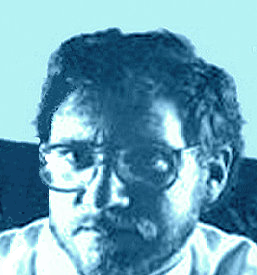
DJ Steve Rabow. 1982
Tom found more allies in 1982 when Seattle radio station KZAM played punk, new wave and post-punk under the moniker ‘Rock of The ‘80s’. Steve Rabow, a DJ at the station, promised to play one song from any cassette sent to him by a separate band on-air for what would become his first ‘Local Tape Extravaganza’. The Rocket magazine (Seattle’s premiere music journal) hopped on-board, providing free promotion for Steve’s project. With the wider promotion, hundreds of tapes got sent Rabow’s way. He played a song from each one of the tapes, as promised, in a four-hour marathon. In 2009 Green Monkey Records released a ‘Best of The 1982 Local Tape Extravaganza’.
One of those tapes was sent by Mr. Epp and The Calculations, an as-yet theoretical band named after their math teacher at Bellevue Christian High School, Mr. Larry Epp, The ‘cassette’ sent to Rabow was (like others) presumably taped on a consumer cassette player with a condenser microphone. Rabow did indeed play the ‘song’ on-air and then pronounced Mr. Epp and The Calculations to be “the worst band in the world”.
Despite the title-or probably because of it-Mr Epp began to play live gigs in all-ages clubs and halls, partly because they were all minors, but also because they knew who their natural audience was.
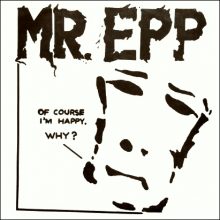
Mr. Epp. Pravda Records. 1982 Cover by Todd Why & Mark Arm
In February 1982 John Rogers of the band Student Nurse produced the first and only vinyl single by Mr. Epp and The Calculations’. The result was a 7” EP called ‘Of Course I’m Happy. Why? released on Seattle’s Pravda Records. The lead song from the EP, ‘Mohawk Man’.unexpectedly rose to number one on Rodney Bingenheimer’s influential ‘Rodney on The ROQ’ show out of Los Angeles station KROQ. College radio around the country followed Bingenheimer’s lead. Despite being truly devoid of musicality the band created enough excitement and chaos to make up for their lack of mastery. Within a year they became one of alternative Seattle’s biggest draws, especially among under-aged kids. The Eppsters knew who their natural audience was, and their audience loved them for it.
Musically they had nothing to do with what would eventually become known as “grunge” despite the insistence of clueless writers, historians, and even some fans to name Mr. Epp as Seattle’s first “grunge” band. It’s well-known lore that the term “grunge“ as applied to Seattle bands, came from simple self-mockery by one of Mr. Epp’s members. A letter published in the July 22, 1981 issue of Seattle alternative journal Desperate Times called Mr. Epp “Pure grunge! Pure noise! Pure Shit!”
It was Mark Arm (Mark Thomas McLaughlin) of Mr. Epp that wrote the sarcastic letter before the band had even played live. Ironically, Mark later became a member of Green River and Mudhoney, both of whom were two of the earliest ‘legitimate’ ‘grunge’ bands…inasmuch as the term “grunge” really means anything. A few years after the letter to Desperate Times Bruce Pavitt and Megan Jasper of Sub-Pop Records used the term jokingly to writers who were noticing the rise of Seattle’s music scene. It was an inside joke, but it stuck.
In 1983 Tom produced Mr. Epp’s song ‘Out of Control’ at Jack Weaver’s Triangle Studios-later to become Jack Endino’s Reciprocal Recording. The track was slated for inclusion on the Engram Records compilation Seattle Syndrome II before the track was even recorded. Tom says “That’s when the Mr. Epp guys were ‘Bellevue Brats’, Bellevue being an upscale suburb of Seattle. I offer no objections because it is, for the most part, true.
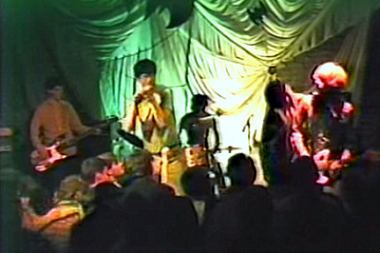
Mr. Epp. The Metropolis Feb. 3, 1994
The band members had the kind of smarmy disrespect and distrust of all the ‘adults’ surrounding them that most teenage boys have. Their attitude at the time didn’t reflect teenage rebellion as much as it did smart-ass teenage sarcasm. It didn’t seem to occur to them that all the ‘adults’ they were working with were only 6-7 years older and had created the template from which they would benefit. This had been the attitude of those same ‘adults’ 6-7 years older..Later, they came to see that more clearly.
“I didn’t get credited as the producer on ‘Out of Control’…but no big deal,” Tom says. “The Mr. Epp guys hated that track,” Tom says. “They hated Jack Weaver,” Triangle’s Studios‘ owner who engineered the song. “They stayed back in the recording room while Jack gave the instructions, Tom recalls. “I went back and forth and conveyed messages. It was pretty funny. Jack had a high opinion of himself.”
Aside from the John Rogers produced 7” EP and the later fiasco with Jack Weaver, Tom tells me “I recorded everything else Mr. Epp did. “I recorded most of the stuff on Four-Track.” The irony is that Tom knew how to record Mr. Epp but none of their tracks were initially released on Green Monkey Records aside from ‘Falling‘ on the ‘Local Product’ compilation. Most of what Tom recorded for them was released on various members’ own small labels. Tom would later release their music on compilations or as re-issues.
Recently Joe Smitty (Jeff Smith) of Mr. Epp said:
“Tom Dyer is great. He was a wonderful producer for Mr. Epp. He listened and helped us do what we wanted to do which was super rare in the 80s. Most tech folks wished they were working for Van Halen, not us!
Green Monkey was slowly building its early catalog. 1983 saw another solo release by Tom Dyer called ‘I Lived Three Lives”, the previously unreleased recording of Me Three called ‘No Money…No Fun’ ‘and ‘Fight Back’ by the Bombardiers; a band led by one of Tom’s old friends, Al Bloch. 1984 saw releases by Prudence Dredge, Liquid Generation, The Elements and what would become Green Monkey Records’ flagship artist, The Green Pajamas.
In the summer of 1984, Tom discovered a self-released cassette at one of the many record stores that once were scattered along Seattle’s University Way (commonly known as ‘The Ave.’). The tape was ‘Summer of Lust’ by Seattle trio Joe Ross on bass, Jeff Kelly as the guitarist and lead singer, and Karl Wilhelm on drums. They called themselves The Green Pajamas.
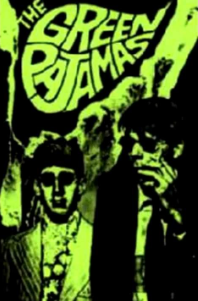
Summer of Lust. Cassette 1984. Cover Art by Joe Ross
On a whim, Tom bought the tape, brought it home and had a listen. He liked the cassette so much that he wrote a review of it for OP Magazine, then published by John Foster (another TESC alum) and the Lost Music Network out of Olympia. OP had become an internationally-known journal dedicated to alternative music and cassette culture. Later the magazine was sold to Scott Becker and well-known music and pop culture author Richie Unterberger. After relocating to Los Angeles OP relaunched itself as Option magazine and despite being a meticulously-designed glossy magazine it kept its credibility among readers. A mention in OP or Option assured exposure to a very wide audience of independent music insiders, College DJ’s and forward-looking music fans. The review was a great move for The Green Pajamas, for Dyer, and for Green Monkey Records.
Tom says he wanted to work with The Green Pajamas from the moment he heard their tape, but no contact information was on the cassette or its cover. He was finally was able to track them down through the shop that duplicated the tape. They put him in touch with band-member Joe Ross. This connection would lead to the association of The Green Pajamas, it’s members, Tom Dyer and Green Monkey Records for 35 years and counting.
After connecting with the band’s members Tom invited them to come over and look at his studio. “Years later,” Jeff Kelly says, “Tom told me he said to himself, ‘I don’t know about this Jeff guy.’ He thought I didn’t seem very friendly when we came over and looked at the studio. I don’t know… I was slightly apprehensive because it was just such a little space and I’d already been in a bigger studio. Maybe I was a little…well, maybe he thought I was aloof, but I probably was just being kind of shy and a little guarded. We ended up recording and it and it was really fun.”
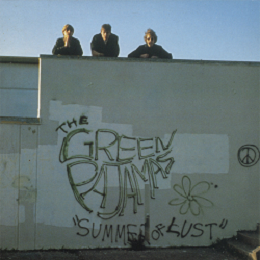
Summer of Lust LP. Ubik Records 1989 Cover Photo: Kari Dunn
Tom’s first move was to re-release ‘Summer of Lust’ on the Green Monkey label with a couple of additional songs-’Stephanie Barber’ and ‘Mike Brown’. “I was amused by the fact that Jeff Kelly would write songs about people using their real names,” Tom says. “When we licensed ‘Summer of Lust’ to the British label Ubik Records in 1989 and the Spanish label ViNiLiSSSiMO in 2014 ‘Mike Brown’ made it to the vinyl versions but ‘Stephanie Barber’ didn’t.
On other occasions, Tom and the band had their own fun preparing albums for overseas release. Tracks were changed around, sometimes there were additions and other times they included alternate takes of the version that appeared on the Green Monkey version. Whether this was a conscious effort to make certain releases more ‘collectible’ there are plenty of Green Pajamas completist collectors who will track down even the most obscure variation. Although Green Monkey has always been a modest operation, the label and The Green Pajamas who practically never played outside Seattle both have a very dedicated worldwide cult following.
In the liner notes for the 2009 compilation ‘It Crawled From The Basement’ Tom wrote about the shift the entire label experienced once The Green Pajamas climbed on board:
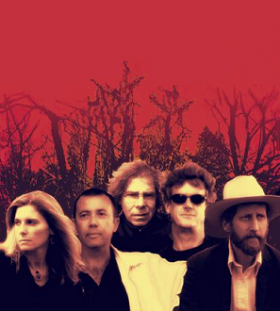
The Green Pajamas. L.to R. Laura Weller Eric Lichter, Jeff Kelly, Scott Vanderpool, Joe Ross
“I didn’t know my life was about to become Pajama-fied. Of the label’s remaining thirty-five releases (between 1982 and 1999) fifteen of them would be by The Green Pajamas or one of their members; usually the brilliant Jeff Kelly. The Pajamas were one of only two bands I ever had a real contract with (The Life was the other). The Pajamas deal was that I paid for everything. I was going to be a real record company, just like Warner Brothers or CBS, honestly! Besides that, I was managing them, I was their producer, their recording engineer, I was booking their shows, I was their publisher. It was fundamentally a conflict of interest situation, but no one else wanted to do it and it needed to be done. I was even Jeff’s best man at his wedding. Green Monkey to a large extent shifted from being the “Tom label” and became the “Jeff label”.
“When Green Monkey started we were releasing cassettes only. It wasn’t just because they were trendy. We just didn’t have the money,” Tom tells me. This was at the height of ‘cassette culture’-the first time in history artists had the ability to record themselves, then copy and distribute their work at an affordable price. Major labels were releasing far more cassettes than LP’s at the time, and small labels and consumers relied on the cassette to get the music they liked spread more widely.
It was the golden age of the ‘mixtape’-a collection of people’s favorite songs, recorded from the original source that was kept for later play, given as gifts, or traded among friends. The wide availability of the cassette tape also freed up artists and small labels from having to manufacture large, set quantities of vinyl records that must be produced and most of them sold to break even. If a person or label had the right equipment, cassettes could be released in modest or relatively large numbers. If the label copied either 30 or 300 cassettes, and they sold out, the label could go back and make more copies. There was a lot less risk of sitting on unsold merchandise. Rapid cassette duplicating shops, who could copy dozens of tapes at a time, popped up all over the nation.
“I think the first 7” vinyl single Green Monkey released was ‘I Love You’ b/w ‘1/4 To Zen‘ by Liquid Generation in 1985. The first 12” vinyl release was another Green Monkey compilation called ‘Monkey Business’ that was released in 1986,” Tom says. “The Fastbacks, The Green Pajamas, Prudence Dredge, The Walkabouts, The Icons, Al Bloch and Arms Akimbo were among the contributors to the album.”
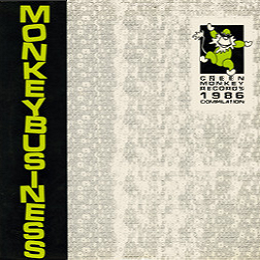
Monkey Business (Compilation) 1986
“The ‘Monkey Business’ compilation, which was actually released on the cusp of 1986, took everything up another notch,” Tom says. “My non-music life had been problematic, to say the least. I had a little construction business with a partner that I did not know was a cocaine freak. ‘Whoops! There went the money!’ I spent six months completing people’s kitchen remodels on my own. As I was getting to the end of all that bad voodoo, I wanted to bust out. ‘Monkey Business’ was the way I did it,” Tom tells me, adding “It was a serious piece of work to show what I could do. Unlike ‘Local Product’, this was mostly bands you could go somewhere and see”.
“It’s the compilation of emerging grunge bands called ‘Deep Six’ that everybody remembers from 1986,” Tom tells me… “but The Rocket gave ‘Monkey Business’ the prize for the best compilation that year. It did even better than those shitty old ‘Deep Six’ and Pop Llama Records ‘12” Combo Deluxe’ compilations,” Tom says with a good-natured laugh. ‘Deep Six’ had included Green River, Malfunkshun, Mudhoney, The Melvins, Soundgarden, The U-Men and Skinyard -bands that would emerge during Seattle’s “grunge” era. Pop Llama Records’ ‘12” Combo Deluxe’ featured The Young Fresh Fellows, Red Dress, The Fastbacks, Moving Parts. Rob Morgan’s New Age Urban Squirrels and Jimmy Silva among others.
“Back in 1986, when ‘Monkey Business’, ‘Deep Six and ’12” Combo Deluxe’ were released, Seattle was Compilation City,” Tom says.
Green Monkey Records upped its pace in 1985 by releasing The Queen Annes, The Fall-Outs, Keith Livingston and both Icons albums ‘Masters of Disaster’ and ‘Live At The Hall of Fame’.
Although The Green Pajamas recorded a new single in 1985 it’s release was put on hold until May 1986. According to Tom, he kept the singles hidden in a closet and told everyone in the band except Jeff Kelly that the records had been held up in customs at the Canadian border. We were trying to be strategic,” Tom tells me. “We wanted to release ‘Monkey Business’ first and then allow enough time for the next Green Pajamas single to take over the attention.”
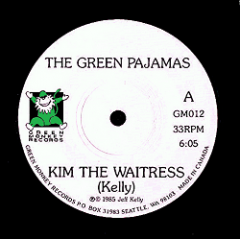
Kim The Waitress. 1986
The single included a song that is probably the most important release that Green Monkey has ever put out: ‘Kim The Waitress’. It turned the fortunes of The Green Pajamas and made Green Monkey Records a player on the local label scene. The song was a modest regional hit, and was played on college stations around the country…but it would find a bigger audience later.
In ‘Loser‘, Clark Humphry excellent book about Seattle alternative music culture he notes: “(The Green Pajamas) scored a regional hit in 1986 with the dreamy love-ode ‘Kim The Waitress‘, clocking in at over six minutes of ethereal innocence. Dyer mixed a shorter version for airplay on (radio station) KJET, whose automation equipment couldn’t play tapes longer than five minutes.” Tom tells me he made the shorter version simply by speeding up the tape a little and editing out parts, mostly during the song’ latter portions.
According to Jeff Kelly;
“We were performing at the time, but we weren’t getting much radio support. KCMU (predecessor of KEXP) would play a little Green Pajamas once in a while, but we were still kind of a novelty. We weren’t ‘grunge’ so our music didn’t fit into anything like that…but Jonathan Poneman (later of SubPop) would play it when he was a DJ at KCMU on one of those late-night shows. We got on there, but never became any kind of a hit. I think in that sense local radio playing our version. The 1994 Sister Psychic version got played a lot locally.
Joe Ross also tells me ‘Kim The Waitress’ was published by Tom’s ‘Half the World Publishing’ but Tom didn’t have the publishing machine to get the song out there. “One thing Tom made sure to do was to promote the single by sending it to almost every college radio station in the U.S. “I wasn’t in the band at the time the record came out,” Joe tells me, “I was working as the activities co-ordinator at South Seattle Community College. We got a promo copy of it. Tom sent out about hundreds of copies. Anyone involved in Material Issue (who later covered ‘Kim The Waitress’ ) was probably in college in Chicago or somewhere else at the time. College radio around the nation received it, so there was some play outside of the Seattle area.”

Material Issue covered ‘Kim The Waitress’ for their 1996 album ‘Freak City Soundtrack,’ L to R: Jim Ells, Mike Zelenko, Ted Ansari
“I thought ‘Kim The Waitress’ could have been-and should have been- a bigger record if I’d known what I was doing… or we just got lucky, but that’s how it went,” Tom says. “Kim The Waitress’ was covered by both power-pop trio Material Issue on their ‘Freak City Soundtrack’ and a notable video was created for it. Seattle’s Sister Psychic covered it for their album ‘Surrender, You Freak. Ironically both covers were released in the same year-1994. Andy Davenhall of Sister Psychic even sat in with the Pajamas on the live version of ‘Kim The Waitress’ that appears on the ‘Lust Never Sleeps’ album. “It was nice getting covered but I still like the original Green Pajamas version the best,” Tom says. He’s not alone in that regard.
In retrospect, Tom may not have had a huge publishing machine, but he was doing one of the most important jobs of a publisher-to get a song heard by as many people as possible and hope someone likes it enough to cover it or use it in TV, radio or film. It’s a tried and true formula that is even more widely used today in the world of digital music. The only real difference is that small labels and unknown bands can do their own footwork without the expense of paying someone with PR connections, the costs of the physical product and postage costs that sending those copies to labels and publishers like Tom’s had to rely on. In the end, Tom’s strategy worked.
He then gives me some of the technical details that went into the recording of ‘Kim The Waitress’:
“The song was recorded on a Tascam 38-8 8-track in my tiny basement studio, with a Soundcraft 16 channel board with an assortment of inexpensive mics – SM-57, Sennheiser MD-421, etc. I think we tracked it with drums, bass, and 2 electric guitars. Vocals were overdubbed as was the sitar, played by the late Steve Lawrence. Mixing was done with minimal outboard gear – a couple of EQs, an Ibanez AD202 Analog delay. I think some kind of reverb but I don’t remember what. I did not own any compressors or other fancy outboard processing gear.”
1986 would also see another watershed moment for both Green Monkey and The Green Pajamas.with the release of The Green Pajamas’ second album, ‘Book of Hours’. It had been two years since ‘Summer of Lust’ and the band had taken on keyboardist Bruce Haedt and Steve Lawrence on guitar. There had been considerable expectation that this album would be as good as ‘Summer of Lust’, or the single ‘Kim The Waitress’.
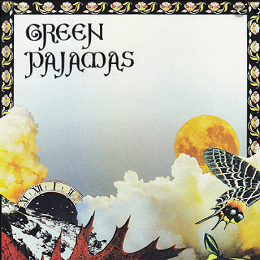
Book of Hours. 1986. Cover Art by: Ursula Bolimowski
‘Book of Hours’ was practically epic in its use musicians, including a choir, a horn section as well as Carla Torgeson of The Walkabouts playing the cello. In 2010, critic Tim Peacock reminded readers that 1987 was the year “grunge” began taking hold in Seattle. He wrote about ‘Book of Hours’ saying, “The idea of a Seattle band laying down a fragrant, patchouli-tinged psychedelic pop masterpiece in such a climate was brave at best.”
Elsewhere Peacock wrote:
“While ‘Book of Hours’ may superficially have been drenched in Eau de 1967, if you’re expecting an unfocused sprawl akin to The Stones’ ‘Their Satanic Majesties Request’ then forget it because there’s also a modern-day energy at work here, not to mention Jeff Kelly’s redoubtable brilliant song-writing skills, all of which conspire to ensure the ...’ Book of Hours’ is an inspired listen over two decades on”.
It’s been three decades now, Tim.
‘Book of Hours’ set the stage for an even closer relationship between The Green Pajamas and Tom Dyer.It also became the first Green Monkey album to find labels and distribution outside the United States. The Bouncing Corporation in Germany released ‘Book of Hours’ in 1988, and Melbourne Australia’s Au-Go-Go Records released the album in 1989. Green Monkey and The Green Pajamas would continue to have albums licensed and released on labels across the world. Later releases would be picked up by Sugarbush Records in Britain, and Camera Obscura in Australia.
Between 1982 and 1991 the Green Monkey catalog grew to include more releases by The Green Pajamas, its primary songwriter, Jeff Kelly, Capping Day, The Life, The Purdins, Slam Suzanne, Goblin Market, and The Hitmen among others. By the end of 1991 Green Monkey Records had released 43 cassettes, 7” singles, and LPs. Tom had either produced or engineered most of them. He decided it was time to shut the operation down…at least for the time being.
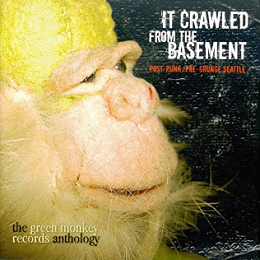
It Crawled From The Basement. 2009 Cover Art: Concept, Art Chantry. Photo: Tom Dyer
“What really happened.” Tom tells me, “was that I was doing too many things, to put it mildly. I started teaching at the Art Institute of Seattle in 1989. I had no degree of any sort. I decided that I liked teaching and I said to myself, ‘go back to school’. At that point, I basically shut down the label and did go back to school. When I began I had no degree at all and ended up with a doctorate. It was a fairly large project. I went to the University of Washington for a couple of degrees then I went out to Johnson and Wales University in Providence, Rhode Island and got my doctorate…I’m not the kind of doctor you’d want operating on your leg,” Tom says jokingly. “ I got my doctorate, headed back to Seattle and started up Green Monkey again. I’ve put out way more stuff now than I did the first time.”
Even while Green Monkey Records was ‘inactive’ the label still managed to release two solo albums by Jeff Kelly, Private Electrical Storm, mixed by Tom in 1992, and 1995’s Ash Wednesday Rain that Tom found time to master. Tom even edited and mastered The Green Pajamas ‘Carolers Song EP’ for its 2001 release on Urbana Illinois label Hidden Agenda. The EP would later be re-released by Green Monkey.
In 2009, after a 14-year ‘hiatus’ Green Monkey Records was relaunched with ‘It Crawled From The Basement’, a 47 song, two-CD set that included a 28-page booklet. Tom says: “It was a compilation that summarized the ‘80’s stuff. The CD was Green Monkey’s first release since Jeff Kelly’s ‘Ash Wednesday Rain’ in 1995. It was a retrospective that marked the beginning of a new era. When ‘It Crawled From The Basement’ was released, Tom wrote: “This CD is the first of many new releases for the label, with re-releases of back catalog, various historical oddities and all-new material by GMR superstars on the way!”
Tom has kept his promise.
“Most indie labels never recoup the investment that they’ve put into their projects. That’s alright,” Tom says. “I wanted to do ‘It Crawled From The Basement’ just so. I didn’t care how much it cost. I just wanted to make it how I wanted to make it. I spent $4000 putting out the compilation. So I said ‘you know what? That’s really a lot of money to toss down the tube. You should recoup it’…but I didn’t come close to it”. Tom says he didn’t really care about the loss. He figured someone would come along and license the compilation. Tom’s had a lot of luck licensing and distribution of his albums in the past. He tells me he figured out how to make his product cheaply early on, and even makes a little money off his releases nowadays. “My hourly wage is probably about 25 cents an hour,” Tom says, That’s a common wage modestly successful indie record owners usually make. “But I don’t lose money on it anymore”.
During our conversation, Tom tells me “I also do some publishing now. I do it to help bands out but it’s really a question of what you’re going to do with it. Most of the stuff we just get it played by people….we don’t get it covered. It’s just whatever royalties we can get from the internet. You don’t get rich doing that! If you want to make some dough, you’ve got to get somebody famous to cover your shit. Jeff always wants people to cover shit, but I just don’t want to work that hard at it.” I say: ‘Jeff, that sounds like a fucking job to me. I’m old now. I’m retired. I’ve worked hard.’
Since Green Monkey’s rise from the ashes in 2009 Tom’s friend and former bandmate Howie Wahlen has taken some of the burden off Tom’s go-it-alone work ethic. I give Howie a call to get the lowdown: He tells me:
“Tom and I met in the mid-‘70s. We kept in touch over the years. He convinced me to join his band The Adults in 1980. I played with them for about six months. About two years later Tom ended up forming Green Monkey Records. After I left Peaches (the one-time national record retailer) he talked me into doing sales for Green Monkey. In about 1989 or 1990 I used to do record and tape consignments with all the record stores around Seattle. I also had my own small label at the time called ‘Other River Music‘. We put out two CDs; ‘Lightning Waltz’ by Like Rain in 1991 and ‘Bad Acid Comedy’ by The Malchicks in 1992.
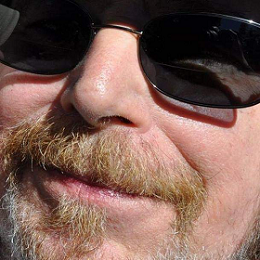
Howie Wahlen. Selfie by Howie Wahlen
Howie tells me he was booking some shows for The Green Pajamas around the time the ‘Ghosts of Love’ album came out in September of 1990. Besides doing consignment as well as managing the band Like Rain and his label, he says ”it was all kind of pulled together.” He says he was also working with Terry Morgan, one of the most important independent promoters in Seattle. “I took on booking at the New Melody Tavern in Ballard, which is now the Tractor Tavern,” Howie tells me. “Terry had started an ‘unplugged’ event every Wednesday night. I did that for a year.”
“Then I got a real job….one with a regular paycheck,“ Howie says. “That pretty much ended the consignment thing with Green Monkey. Tom shut the label down so he could study and eventually go off to Rhode Island. When he came back to Seattle, I was a truck driver. Tom took a position as President of Argosy University, a small institution in Seattle that gives out master’s degrees.
Howie tells me that Tom called him one day after Green Monkey had been re-launched. He says Tom asked him ‘Hey! You wanna do some stuff?’. Howie says he was reluctant at first. His truck driving job was really good, but it didn’t afford him a lot of time and the hours were horrendous. “Tom asked me what I’d like to do.” Howie says that he finally told Tom, yes, but this time he’d like to get involved in a more creative way. “I wasn’t really interested in doing sales. I didn’t I have the time or the desire to do it”
The two hashed it out and came up with Howie being in charge of video. “ It was a learning process, Howie says. “I was shooting, directing, editing, working as the videographer and doing all the production,” according to Howie. “I happened to have archives from the late 1980s when myself and a friend had videotaped quite a few local bands. I’d forgotten about some of that stuff!” Howie tells me, he recently put together a video for the August 2019 release of ‘The Incomplete Fabulous Stinking’ retrospective by The Chemistry Set.
“I happened to have a videotape of a show that the Chemistry Set played at The Backstage nightclub in Ballard years ago,” Howie says. “ I also had videotaped The Life at The Backstage on a Green Monkey Night. I’ve scaled back from the videos quite a bit, but I still help… What I do mostly is to allow Tom to pick my brain. I’ve spent a lot of time in retail and working in warehouses, as well as booking shows. He runs things by me and I give him my opinion. He bounces ideas off me and occasionally he’ll grab something from me and run with it.” Howie doesn’t mention that he also does a fair amount of writing both for Green Monkey and the press. Besides video Howie was doing most of the updating of the original Green Monkey Records website and keeping content current. He usually set up the Album of the Month page with templates that Tom had already had set up.
I ask Howie how he would define his position at Green Monkey Records. He laughs and says:
“One time Tom asked me that same question. I said ‘Gosh Tom, I’ve never been a Vice President of anything. You’re obviously the President, so can I be your Vice President?’ He said, ‘Sure! Why not?’ ”
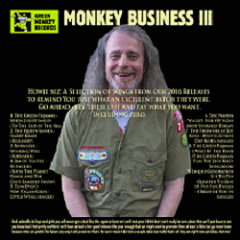
Monkey Business III. (compilation) 2016
Since it’s relaunch Green Monkey Records has continued to release albums that had sat in the can for years. The label has also re-released previously cassette-only tapes and long out-of-print albums. During the past decade, the label has released albums by Tom Dyer and the different configurations of bands he’s been in, The Green Pajamas, The Life, The Icons. The Goblin Market, Jim of Seattle, The Colorplates, Liquid Generation, The Queen Annes, Gary Minkler, Slam Suzanne, the late and sorely missed George Romansic, Fur For Fairies, The Freewheelin’ Joe Ross, The Dehumanizers, AAIIEE. Amy Denio, The Chemistry Set…and that’s barely scratching the surface. Tom’s label has continued to release a total of three Monkey Business compilations, the second being in 2006 although one’s title is actually Monkey Business: Mach II released in January of 2016. It was made up of selections chosen by Howie, as was 2017’s Monkey Business III
This was obviously a great move because so many of the albums were initially put out on cassette tapes. A newly mastered CD or a digital copy of an old tape is always attractive to fans of the original. Many of them were destroyed, lost or forgotten over the years. “I was worried about some of the older releases. I wanted them to have a public life again, Tom tells me. I wanted to make them available so someone could find them if they wanted some really weird, obscure shit.”
“I wrapped most of that up a couple of years ago. There’s still a couple of little things, but I’m not much I’m worried about putting out old stuff. I’m focusing on the new releases at this point.”
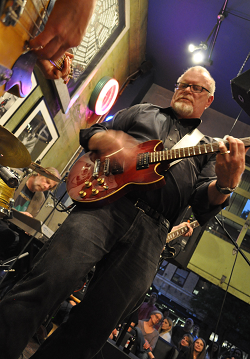
Tom Dyer at Easy St. Records with The New Pagan Gods. Photo: Howie Wahlen
“I currently have a studio in my house,” Tom tells me. “I have a nice pro-tools rig but I don’t record whole bands that often. They usually don’t want to work that hard. My own current band is ‘Tom Dyer and the True Olympians. (Tom Dyer, vocals and guitar, Joe Cason, keyboards and vocals, Gene Tveden, bass and vocals, and Tom Shoblom, drums, and percussion) The band has been together since 2017 and has released two singles and one album and done two gigs. “We’re working on our next album right now,” Tom tells me.
Tom’s been involved with other bands in the past couple of decades. Obviously The Icons were together when he first started Green Monkey and they held a reunion show and recorded an album in 2009 for the relaunch of the label. “There was a 2 gig band of all improvised rock songs in 86 or 87 – New Pagan Gods – with a bunch of guys on the label, Tom says, adding “It was pretty fun”. In 1992 I put together a short-lived band called Beautimus, Tom says. They recorded 8 songs and did one gig In 2015 a different line up of New Pagan Gods recorded ‘History of NW Rock: Volume 1‘ and played two shows. Tom adds “those shows were ‘so fun’.
I mention to Tom that I think Green Monkey Records has a very strong presence on the web. The actual Green Monkey site is comprehensive and easy to navigate. Aside from Green Monkey having a page for each of its bands, comments, albums of the month, direct downloads and a sales point the site also links to the websites that individual artists have put up themselves. There are pages filled with what Tom calls his “rants” news and video. There is also a particularly fine hand-in-glove site at Bandcamp.
“I have fun doing it. I do the parts that I like and if some magic thing happens and one of them gets picked up great! If it doesn’t, that’s fine too. I like to make music that I like”.
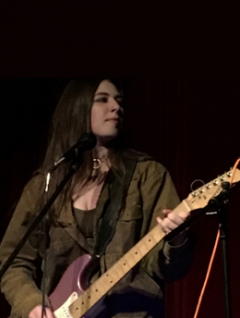
Maggie Teachout
Tom gives it some thought and then says; “There’s stuff that I like better than others. Not every band that releases on the label are my favorite records, and I’ve put out a lot of them, you know? But I like all of them to different degrees. I’ve been putting stuff out lately by kids. I put this record out by this 18-year-old girl from Olympia named Maggie Teachout. Tom tells me “Maggie has super-catchy pop songs. We haven’t done anything yet; I think only three shows in Olympia to promote the album. She didn’t care. She just wanted to make a record, so I said ‘Let’s make a record!’ “It was really fun to do” Her first album, ‘Maybe I’m Still Peter’ was released on Green Monkey Records in August of 2019.”
Later I do a bit of research on Maggie and find out she grew up in Olympia around traditional American music. She was somewhat of a child prodigy who first started playing music when she was four years old and has been a songwriter since she was 13. According to her official bio “she is known in Olympia music circles for her powerful voice and moving lyrics,” The bio also mentions Maggie’s passion for social justice, in several of her songs including ‘Waltz for my Daughter’ which features both Maggie and her younger sister, Ruby of The Bow Weevils...a teen band that plays old-time music, traditional music, fiddle tunes, and ballads. Maggie’s bio describes her first album as a mix of traditional American music with indie-pop. That’s a near-perfect combination.
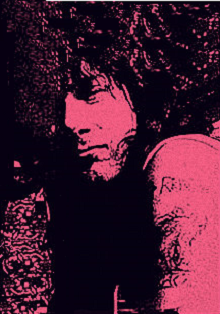
Mike Refuzor 1953-2017
Tom says he’s also got Al Bloch to record a new CD which he thinks is a great accomplishment. “I love Al Bloch’s stuff, Tom tells me,” He hadn’t done anything for ages. He’s writing new material again”. Al played at the Crocodile Cafe on March 3, 2018, with his old band The Cheaters (more or less) for the 40th reunion of Seattle’s first punk rock club ‘The Bird’. Along with The Cheaters, Penelope Houston of The Avengers, The Enemy and Shagnasty, “The official Ken Trader tribute band” played. The show was fantastic but somewhat of a damper was put on it shortly after it took place.
Local punk rock legend Mike Refuzor who had started his career at ‘The Bird’ attended the reunion that night. It was his last public outing. Three days later he was found passed out on a neighborhood sidewalk. He was taken to Harborview Hospital and found to have had a stroke. Mike had suffered a stroke several years earlier that left him partly disabled. He was also in very poor health. Mike never regained consciousness and his family had life support removed after realizing he was not going to make it. As Tom put it “None of us get to stay alive, so…”
Since I’m talking to Tom in mid-September he whispers and tells me in his most covert voice: “I’ve just taken over the most important job in the northwest small label-dom. I’ll be releasing the new Richard Peterson album on October 18. “Popllama producer Conrad Uno threw in the towel so Peter Barnes called me up and asked if I’d do it. I said “Sure! Why not?!!”
Now it’s late October and Richard’s new album ‘Seven’ has indeed been released.
For those not familiar with Richard there is little more to say than ‘Richard Peterson is a Seattle legend’. For decades Richard has been a fixture on the street and at sporting events busking by playing his trumpet (NO CANADIAN COINS!). He is a savant who not only plays the trumpet…he’s quite a pianist as well. Aside from the streets and sports events, Richard can be found playing at galas, parties or even on stage opening for his friend Jeff Bridges’ band, The Abiders (yes, that Jeff Bridges).
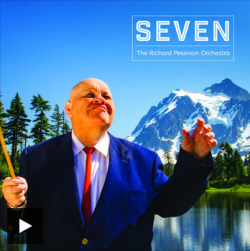
Richard Peterson. Seven. 2019 Cover Photo: Eric Johnson
Richard Peterson’s new album. ‘Seven’, is credited to ‘The Richard Peterson Orchestra, but in fact, every note on the album is his own. For decades Richard has been fascinated with the music for Lloyd Bridges’ role from 1958 to 1961 in the television drama Sea Hunt, hence his becoming friends with Lloyd Bridges’ son Jeff. Music for Sea Hunt was credited to ZIV, en entity that was actually a production company named after Frederik Ziv. Frederik Ziv was a radio and television producer who worked from the 1930s up until the late 1950s. The composer of Sea Hunt’s mysterious underwater music was actually the work of David Rose along with stock music created by other composers. Richard aspires to the same themes and moods used in the old series. Tom tells me that the entire Richard Peterson catalog is now available as digital downloads.
A fantastic documentary about Richard Peterson called ‘Big City Dick’ is must-see watching for Seattleites as well as those not familiar with the city. It was shot in 2004 and won The Slamdance Film Festival’s ‘Sparky Award for Best Documentary Film’ that year. It’s a touching look at Richard and his quest for fame and acceptance. It’s even more poignant knowing that Richard is now 15 years older than he was during filming, and though he does well-enough financially, he is, as he always says “still on the streets”. The documentary is available to watch free at the Green Monkey website….jut look for the ‘videos’ section.
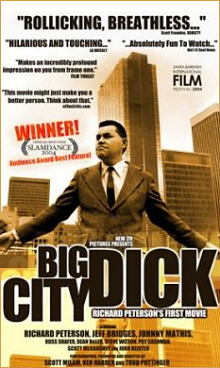
Directed by Ken Harder & Scott Milam. 2004
There are few if any eccentrics left in Seattle that rise to Richard’s status. Richard’s albums have never sold well, but he has a leg up on most other musicians. Richard is happy to stand on downtown Seattle street corners hawking his records to strangers and passers-by. The volatile but talented poet and performance artist Jesse Bernstein is gone. The Doghouse is gone. Dark fantasy author Wilum Hopfrog Pugmire (perhaps Seattle’s oldest punk) is gone. Pre-grunge hangouts like WREX and The Gorilla Room, and the straight-friendly Tugs, Belltown are loooooong gone. Upchuck in his punk-dandy outfits that he wore day and night is gone. The Comet Tavern is still there, but it’s not really ‘The Comet’. Dee Dee Rainbow, who dressed just as you’d imagine is gone. So is the unfathomable painter Jay Steensma and the cheap warehouse’s artists used to rent that have been torn down to make way for a new skyscraper district in South Lake Union. The Green Pajamas, who Tom and Green Monkey Records had been so inextricably tied to has more or less disbanded, although various combinations of the members still record.
But there are a few pockets of Seattle’s past culture that remains. The welcoming neon and flashing-bulbed Elephant Car Wash sign still stands at Denny Way and Wall Street. Improbably in the digital age, the ‘Read All About It’ magazine and newspaper stand at First and Pike is still there. The mighty art maven/provocateur Larry Reid keeps things alive at Fantagraphics Books in Georgetown. Tom Dyer (who’s been around Seattle since 1975) is still here and so is his pre-grunge label…and no Christmas party at Peter Barnes’ Clatter and Din studios would be a real event without Richard Peterson at the ivories.
Let’s back-up a minute to Peter Barnes’ Christmas parties, and Christmas in general. Since 2009 Green Monkey Records has released 9 charity Christmas albums (one year a charity event was held instead of releasing an album). Each year the label puts out a Christmas download featuring Tom, his friends, his label-mates, and in some cases artists who no one seems to know anything about. The collections are fun and as Tom wrote in 2016:
OKAY, YOU JOLLY CHRISTMATOLOGISTS!
“Welcome to another non-denominational Green Monkey Christmas! Here at GMR, we welcome everyone who likes a little Christmas music, regardless of race, creed, color, gender identity, religion, preferred football team and/or voting record.”
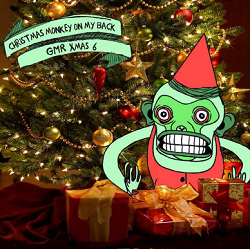
Green Monkey on My Back.
GMR Christmas 6. 2015
Each year the entire proceeds from the albums go to MusicCares. 501(c)(3) organization that assists musicians in need, whether it’s chemical dependency rehab or day-to-day need for elderly and abandoned musicians. Charity Navigator has given MusicCares five stars (their highest rating). According to the MusicCares mission statement:
“MusiCares provides a safety net of critical assistance for music people in times of need. MusiCares’ services and resources cover a wide range of financial, medical and personal emergencies, and each case is treated with integrity and confidentiality. MusiCares also focuses the resources and attention of the music industry on human service issues that directly influence the health and welfare of the music community.”
This year Green Monkey will be releasing two Christmas albums. The first is ‘Hail the Jolly Christmas Monkey: GMR #10’. It will include Tom-n-Joe’s Holiday Agnostics (Tom & Joe from the True Olympians), Olivia Bloch (featuring Kurt and Al Bloch), Utterance Tongue, Wendy Dunlap, Rendition, Levi Fuller; Jeff Kelly & Ed Portnow, Duane Hibbard, Joe Ross, Steve Trettevik, Richard Stuverude, and Cabeza. More artists will possibly be included, among them Richard Peterson. Ben London & Stagg, Steve Fisk, and Toiling Midgets. Tom says there will be a limited run of 100 of Hail the Jolly Christmas Monkey on vinyl this year.
The second is: ‘The Best of Christmas Boogie Woogie – 10 Years of GMR Xmas’, Tom says “Howie is picking the “best of” songs. So far he’s not telling. Both albums will be available on December 1, 2019.
Nowadays Tom’s life seems more relaxed. “I’m coming to Seattle less since I moved to Olympia,” Tom tells me. “I’ve been down here in Olympia a little over three years. The traffic between Olympia and Seattle has gotten so fucking horrible. I still come up to see a show when the traffic isn’t so bad because it’s not so crowded when you’re driving home… but you’ve got to avoid the drunks on the way. My mom lives near Seattle’s Green Lake in a senior home so I get up to Seattle at least once a month. It just depends. I don’t hang out in Seattle like I used to, that’s for sure,” he says.
Green Monkey still doesn’t follow trends. It seems that Tom and Green Monkey Records will continue to release solid, unpretentious rock and pop music…just as it always has. Some people may constantly be in search of the newest, the biggest, the most transformative thing. At the same time, there is time to take in a bit of ‘comfort food for the ears’. Not bland, but tasty, fulfilling and made with love. Green Monkey Records delivers that ‘comfort food’.
 Green Monkey‘s pace may seem to have lessened a bit lately, but since the revival of the label in 2009 Tom’s released an additional 59 CDs, 1 LP, 10 Christmas albums, 14 digital singles, 2 digital compilations, 2 digital-only album: The Heats ‘Live at The Showbox 1979’ and ‘November’ by The Green Pajamas. ‘November’. In 2013 it was released as a CD.
Green Monkey‘s pace may seem to have lessened a bit lately, but since the revival of the label in 2009 Tom’s released an additional 59 CDs, 1 LP, 10 Christmas albums, 14 digital singles, 2 digital compilations, 2 digital-only album: The Heats ‘Live at The Showbox 1979’ and ‘November’ by The Green Pajamas. ‘November’. In 2013 it was released as a CD.
“That comes to 131 releases by my count,” Tom says. “Today I do the parts I like. That’s the way it is. My plan is to just keep putting music out until I’m dead.”
So, some things remain the same-like that happy “stuffed but wise” monkey with arms raised in the air as it’s lumbering towards us to give us a big hug…sans the naughty bits.
NEXT. EVERYTHING’S GONE GREEN PART TWO: THE GREEN PAJAMAS.



